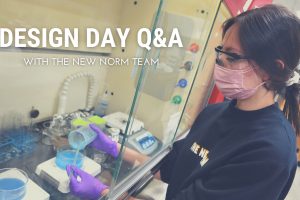
An annual rite of passage, Design Day is an opportunity for engineering students to prove that they can translate theoretical knowledge learned in classrooms and laboratories into creative, practical solutions to real-world problems. As part of this year’s event on Tuesday, May 4, students from around WSE will present their work to sponsors and mentors from industry, faculty members, clinicians, fellow students, and other guests through virtual live and recorded poster sessions and demonstrations.
One project that attendees will learn about is work being done by materials science and engineering students Abby Weyer and Benjamin Balfanz under the auspices of The New Norm, a startup that seeks to reduce the amount of plastic in landfills by turning red Solo™ cups into sustainable, vibrant fabric for clothing. The company was founded by WSE alumna Lauren Choi ’20.
We recently caught up with Weyer and Balfanz to learn more about their project.
Q: What processes are you refining or contributing to at The New Norm?
Weyer: [We have] been working on methods of acquiring raw polystyrene from Solo cups using d-limonene, a natural solvent for polystyrene derived from citrus rinds. By dissolving the cups in d-limonene and extracting the d-limonene in different ways, we are able to produce polystyrene either in bulk or thread form.
Balfanz: We have also been doing research related to how to blend the polystyrene with other polymers to achieve a filament with improved properties for clothing. On that end, we have been working with Lauren and a polymer lab to create varying formulations and mechanically test them.
Q: What was the biggest challenge you faced?
Balfanz: I would say the biggest challenge has been narrowing our focus enough to see a line of research through to the end within our shortened timeframe. We’ve found so many different facets of this question that have been fascinating to learn about, to the point where it’s been somewhat difficult to convince ourselves to conclude a branch once it becomes more challenging, rather than just move onto something equally as interesting.
Q: What impact did the need to work largely remotely have on you and your team?
Balfanz: Since the whole school was fully remote last semester, we weren’t able to perform any in-person research, which limited us to reviewing existing literature to develop our plans for the following semester. Now that we’re allowed lab access, we’ve made a lot more progress with our project. While the hybrid online/in-person formatting has overall been challenging, it’s certainly helped the team become more flexible with coming into the lab, and more consistent with our organization on Google Drive.
Q: How important has this senior design experience been to your materials science and engineering education?
Weyer: This project is meaningful to us because we don’t think there is anything like it at Hopkins. In our major, we work with materials every day but rarely think about what happens to them at the end of their life cycle. This project has the potential to inspire future innovation in plastics recycling and eliminate common waste and pollutants in standard fabric manufacturing. The impact could be enormous.
By: Lisa Ercolano